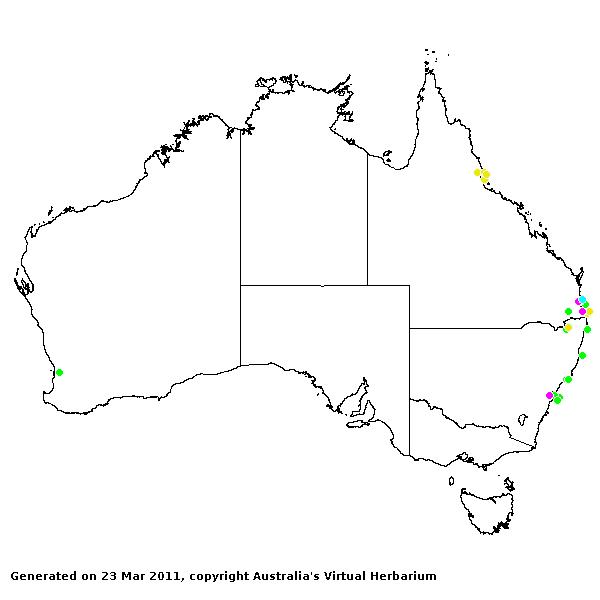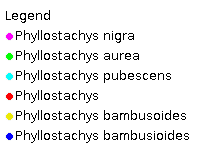Phyllostachys* Abh. Math.-Phys. Kon. Bayer. Akad. 3: 745 (1843).
Derivation:. From Greek phyllos (leaf) and stachys (spike).
Key references (keys and floras):. B.K.Simon, Key to Australian Grasses 145 (1993); S.W.L.Jacobs and S.M.Hastings, Flora of New South Wales 4: 655–656 (1993); E.Edgar and H.E.Connor, Flora of New Zealand 5: 25–29 (2000); D.Sharp and B.K.Simon, AusGrass (2002); J.P.Jessop, Grasses of South Australia 53 (2006); S.W.L.Jacobs, R.D.B.Whalley & D.J.B.Wheeler, Grasses of New South Wales, 4th ed, 340–341 (2008); A.Wilson (ed.), Flora of Australia 44A: Poaceae 2: 357–358 (2009).
W.D.Clayton & S.A.Renvoize, Genera Graminum (1986), genus (29).
Naturalised. About 50 species, from eastern Asia. 3 species in Australia, Qld and NSW. Also Malesia and New Zealand.
Habit. Arborescent or shrubby perennial, rhizomatous. Culms woody and persistent. Leaf blades broad. Leaf-blades pseudo-petiolate. Ligule a fringed membrane.
Inflorescence. Inflorescence compound paniculate (of spicate, 1-spikeleted branchlets, aggregated into spatheate clusters), an open panicle with branches ending in single spikelets, spatheate, a compound pseudo-inflorescence (with or without foliage leaves). Spikelet-bearing axes much reduced and racemes, clustered.
Spikelets. Spikelets laterally compressed to subterete, more than 2 flowered, with 1 fertile floret or with 2 or more fertile florets, solitary; with naked rachilla extension. Fertile spikelets disarticulating above glumes.
Glumes. Glumes one per spikelet or two (or 3, and the lateral spikelets with an outer bract at the base), shorter than adjacent lemmas, pointed, awnless. Lower glume many-nerved. Upper glume many nerved.
Florets. Fertile florets 1–4. Lemmas entire at apex, pointed, muticous or mucronate (?), lemmas many veined, 1 keeled to not keeled. Palea relatively long, apically notched, awnless, without apical setae to with apical setae, several nerved. Lodicules 2, or 3. Stamens 3. Grain longitudinally grooved. Embryo small.
Kranz Anatomy. C3.
2n = 24 (rarely) or 48 or 72, 2 ploid or 4 ploid or 6 ploid.
Classification. Bambusoideae; Bambuseae.


Types Species. P. bambusoides Siebold & Zucc.
Biogeographic Element. Clifford & Simon 1981, Simon & Jacobs 1990: Naturalised.
